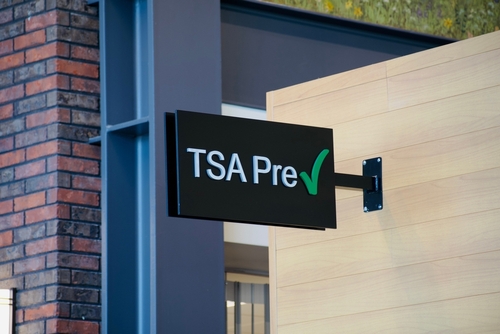Airport security can be one of the more challenging aspects of flying. But there are ways to avoid long security lines and customs delays: through programs like TSA PreCheck and Global Entry. Part of the US Department of Homeland Security’s Trusted Traveler Programs, these initiatives provide expedited screening for low-risk travelers.
The idea is to make it quicker and easier for people who travel frequently to pass through security screening and get to where they’re going. But if you’re considering Global Entry vs. TSA PreCheck, there are some important differences between these two systems.
At Remitly, we believe in making it as easy as possible to explore the world, so in this article, we’ll compare these programs side-by-side. You’ll learn about the benefits of each, how to apply, the costs involved, and how to decide which program best fits your travel habits. Let’s get started.
What is TSA PreCheck?
TSA PreCheck is a program established by the Transportation Security Administration, a section of the Department of Homeland Security, to allow low-risk travelers to go through a faster security screening process at US airports.
You can begin the enrollment process online and then visit an enrollment location to complete it, or do it in-person without an appointment. At the time of writing, PreCheck is available for over 90 airlines at more than 200 airports throughout the US. If you travel frequently, it can save you quite a bit of time and stress.
What TSA PreCheck gives you
If you qualify for PreCheck, you can:
- Keep your shoes on at security screening.
- Leave your laptop in your bag.
- Keep your light jacket and belt on, if you’re wearing them.
- Leave liquids in your bag, as long as they comply with the 3-1-1 rule (no individual container can be more than 3.4 ounces of liquid, and all containers must fit into a quart-sized, clear plastic bag).
- Use dedicated security lines for pre-checked travelers.
These benefits make it easier and quicker to pass through security. That means you can spend less time at the airport and more time enjoying your trip.
It’s no surprise that TSA PreCheck is especially popular with business travelers who pass through airports often. The time you save in the security line can really add up if you take multiple flights per year.
What is Global Entry?
Just like TSA PreCheck, Global Entry can save you time at the airport. However, it has different rules and works in a different way because it’s administered by US Customs and Border Protection.
Global Entry includes all the benefits of TSA PreCheck. That means you can use the same dedicated security screening lines, keep liquids and laptops in your bag, and keep your shoes, belts, and a light jacket on.
But Global Entry also applies to people entering the United States from abroad. You won’t have to fill out customs paperwork on arrival and you’ll be able to use expedited entry lines. As a prescreened traveler, all you have to do is check in at the Global Entry kiosk, then enter the country without hassle. Many airports are now introducing facial recognition and touchless entry, so kiosks may soon become a thing of the past too.
Global Entry is mainly designed for international travelers who frequently travel to the US. It’s available to US citizens and also to citizens of a limited list of foreign countries, including the United Kingdom, Australia, Japan, Mexico, Singapore, the Dominican Republic, India, and the UAE. It’s not open to EU citizens in general, but is available if you are a citizen of the Netherlands, Germany, Switzerland, or Croatia.
Global Entry vs. TSA PreCheck: a head-to-head comparison
TSA PreCheck and Global Entry are both designed to make travel easier, but they work in different ways. Which one works best for you will ultimately depend on the kind of travel you do.
Let’s compare these two programs head-to-head to help you make a decision on which you should apply for.
| Feature | TSA PreCheck | Global Entry |
| Main benefit | Expedited US security screening | Expedited US customs entry (includes security screening) |
| Includes TSA PreCheck benefits | Yes | Yes |
| Best for | Domestic travelers | International travelers |
| Cost | $76.75-$85 USD for 5 years | $120 USD for 5 years |
| Application process | Online application + in-person appointment at an enrollment center | Online application + in-person interview (often at an airport) |
| Required documents | Proof of citizenship (e.g., passport, birth certificate) + valid photo ID | Proof of citizenship (e.g., passport) and residency + valid photo ID |
How to apply for each program
Applying for TSA PreCheck
TSA PreCheck enrollment is provided through enrollment partners Telos, Clear, and Idemia. You can choose any of these three partners and enroll online or in person at an enrollment location.
Each partner charges a slightly different application fee, from $76.75 with Idemia up to $85 with Telos. However, each provider offers different locations and different benefits, so you’ll need to decide which works best for you.
You start your application online by entering your personal information, including your email, cell phone number, name, and identification.
An unexpired passport is ideal, but a Permanent Resident card, an unexpired US Enhanced Driver’s License, or an unexpired foreign passport with an immigrant visa will also work.
If you don’t have any of those documents, you can also apply with a photo ID like a driver’s license or state photo ID accompanied by proof of citizenship.
This can be an expired US passport as long as it expired less than 12 months ago, a US birth certificate, or a US certificate of citizenship.
The online application takes around five minutes. Then you’ll need to visit an enrollment center to complete your application. During this process, the enrollment provider collects your biometric data, including your fingerprints and a photo. They’ll also verify your identity documents and collect payment.
In most cases, approval happens within three to five days. However, if there are issues with your documents, it can take up to 60 days. So it’s definitely not something to leave to the last minute.
Applying for Global Entry
First, you need to have a Trusted Travel Program (TTP) account. Log in to your TTP account and complete the online part of the application. A $120 nonrefundable fee is required with each application.
Once your online application is complete, the information you provide will be reviewed. If everything checks out, you’ll be granted conditional approval and will be instructed to schedule an interview at a Global Entry enrollment center. Bring the documents we mentioned above to the interview.
Note that although this program is intended for international travelers, almost all of the enrollment centers are within the United States. Only Qatar has an enrollment center outside the US and its territories.
To make things easier if you live outside the listed areas, the government also offers an Enrollment on Arrival (EoA) scheme. To take advantage of this, you can apply online for your Global Entry as normal. Then you complete your Global Entry interview the next time you enter the United States.
You’ll need a valid passport and documents providing proof of residency. Driver’s licenses, mortgage statements, rental agreements, and utility bills will work.
Most of the major airports in the US can conduct this interview. It can also be conducted at select airports in countries and territories including Canada, Aruba, Bermuda, Guam, Ireland, the Bahamas, and the UAE.
Global Entry vs. TSA PreCheck: Which program should you choose?
Deciding which of these entry programs works best for you is going to depend on your travel habits. Both are Trusted Traveler programs with similar expedited screening benefits, but they’re intended for different styles of travel.
TSA PreCheck
If you travel frequently within the US on business, for example, and want to move through airport security quicker, TSA PreCheck is probably the best bet.
Global Entry
If you travel internationally, Global Entry offers the same advantages as TSA PreCheck, but also gives you expedited customs processing when you return to the US. So you get to skip long passport control lines, and if you’re taking a domestic flight to get home from the international hub, you get through security quicker on that flight, too.
The difference in cost between these two programs is fairly minimal. Global entry only costs $35-$45 more over five years. That means it’s worth thinking about getting even if you only take one overseas flight per year.
It’s also worth looking at your credit card benefits. Travel credit cards, including ones from Chase, Capital One, and American Express, can give you statement credits that will cover the application fee for either program, making your membership free.
Global Entry vs. TSA PreCheck: the final verdict
Both of these Trusted Traveler Programs offer expedited screening. But the expedited customs clearance of the Global Entry program makes it more desirable for international travelers. Having said that, if you know you’re really only likely to travel within the US, TSA PreCheck is cheaper and may give you what you need.
Both programs offer great value by helping you save time and reducing stress at the airport. But given the small price difference between the two, Global Entry is worth considering if you’re heading overseas.
Ultimately, whichever program you choose, you’ll have an easier and more relaxed time at the airport on your next trip.
FAQs
How long does it take to get approved for Global Entry vs. TSA PreCheck?
In most cases, TSA PreCheck approval only takes a few days, although in some cases it can take up to 60 days. Global Entry requires a more thorough background check, which means applications can take 90 days.
Can my family use my TSA PreCheck or Global Entry benefits?
Children under the age of 17 don’t need their own Known Traveler Number from TSA PreCheck. Children under the age of 12 can join their parents in the TSA PreCheck lanes, and don’t need to have the PreCheck indicator on their boarding pass.
Children between 13 and 17 can join their parents in the TSA PreCheck lane only if they have the PreCheck indicator on their boarding pass.
Global Entry is open to anyone, although children under the age of 18 must have consent from a parent or legal guardian. That means every member of your family needs to have their own membership. However, a parent doesn’t need to be a Global Entry member for their child to apply.
Is Global Entry better than TSA PreCheck?
For international travelers, yes. Global Entry has all the expedited screening benefits of TSA PreCheck, plus expedited customs procedures for travelers entering the US from abroad. It’s only slightly more expensive, but if you never travel outside the US, TSA PreCheck may be all you need.

